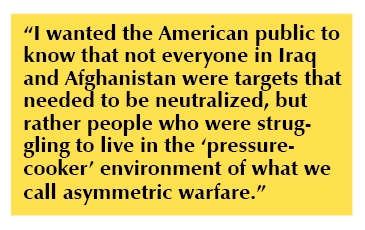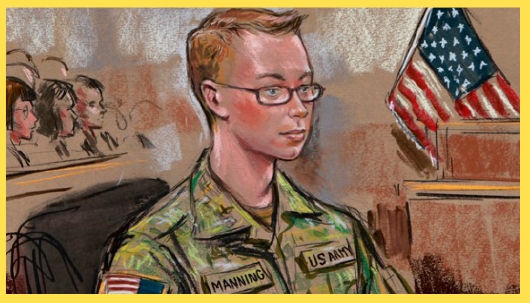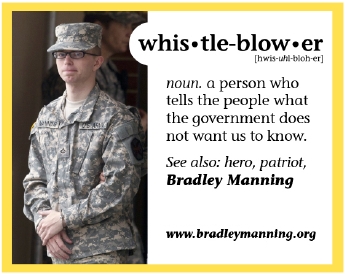On February 28, Private First Class Bradley Manning read a 35-page statement detailing his historic leak of classified information in 2010. Media coverage has at times focused as much on the character and treatment of Manning himself as on the content of the hundreds of thousands of State Department cables, military field reports, and video clips he provided to WikiLeaks.
The picture presented by these documents of the wars in Afghanistan and Iraq (as well as US intentions and movements throughout the world) challenges the paradigm our government presents to the public, undermining any justification for putting our citizens at deadly risk in these military orchestrations. However some commentators have chosen to attack Manning’s character. Without access to the press, Manning has been vilified and his motives questioned. Bill Keller, the chief editor of the New York Times at the time the documents were released by WikiLeaks, recently described Manning as a “nervous, troubled, angry young Army private who was offering not so much documentation of a particular government outrage as a chance to fish in a sea of secrets.”
This type of coverage is misleading and misses the most important questions raised by Manning’s actions. It also does a disservice to the public by obscuring Manning’s voice. The PNL editorial committee chose to provide excerpts of his court statement, not only because of Manning’s importance to the anti-war movement but also because it is the first time in nearly three years that Manning has been able to communicate directly to the public. The statement we excerpt shows that Manning was conscious and intentional in his actions as he speaks with moral clarity about what he saw as a public responsibility to know “the true nature of 21st century asymmetric warfare.”
—Leahann Lynagh, Ben Kuebrich & Amelia Ramsey-Lefevre
Significant Activities (SIGACTs)

Manning has pled guilty to releasing SIGACTs tables for Iraq and Afghanistan, which many media outlets allege are the Afghan and Iraq “War Logs” released by WikiLeaks in 2010. Seventy-five thousand of the Afghan War Logs have been published revealing unreported civilian deaths, misleading and/or unreported friendly fire incidents, the killing or capturing of Taliban leaders without trial, and the increased use of Reaper drones to murder Taliban targets. The Iraq War Logs consist of 391,832 US Army field reports dated from 2004-2009. The reports detail war crimes committed by contractors, rampant abuse, torture and murder of detainees by Iraqi forces, and records of civilian casualties, which both US and UK officials claimed did not exist. To date, the logs comprise the largest data leak in US military history.
As an analyst, I view the SIGACTs as historical data. SIGACTs give a first-look impression of a specific or isolated event. This event can be an Improvised Explosive Device attack, Small Arms Fire engagement with a hostile force, or any other event a specific unit documented and reported in real-time.
In my perspective, the information contained within a single SIGACT or group of SIGACTs is not very sensitive. The events encapsulated within most SIGACTs involve either enemy engagements or causalities. Most of this information is publicly reported by the Public Affairs Office, embedded media pools, or host-nation media.

how and, more importantly, why he leaked military and
government documents. Image: Reuters
As I started working with SIGACTs, I felt they were similar to a daily journal or log that a person may keep. They capture what happens on a particular day and time. They are created immediately after the event and are potentially updated over a period of hours until a final version is published on the Combined Information Data Network Exchange (CIDNE). Normally, within 24 to 48 hours, the updating and reporting of a particular SIGACT is complete.
The CIDNE system contains a database that is used by thousands of Department of Defense personnel, including soldiers, civilians, and contractor support. It was the US Central Command reporting tool for operational reporting in Iraq and Afghanistan. Two separate but similar databases were maintained for each theater, “CIDNE-I” for Iraq and “CIDNE-A” for Afghanistan.
Although SIGACT reporting is sensitive at the time of their creation, their sensitivity normally dissipates within 48 to 72 hours as the information is either publicly released or the unit involved is no longer in the area and not in danger.
WikiLeaks Organization (WLO)
WikiLeaks publishes secret information, news leaks, and classified media from anonymous sources. Visit wikileaks.org for additional information.
I conducted searches on both Non-classified Internet Protocol Router Network and Secure Internet Protocol Router Network on WLO beginning in late November 2009 and early December 2009.
After seeing the information available on the WLO website, I continued following it and collecting open-source information from it. During this time period, I followed several organizations and groups, including wire press agencies such as the Associated Press and Reuters, and private intelligence agencies including Strategic Forecasting. This practice was something I was trained to do during Advanced Individual Training and was something that good analysts are expected to do.
I felt we were risking so much for people that seemed unwilling to cooperate with us, leading to frustration and hatred on both sides. I began to become depressed at the situation that we found ourselves increasingly mired in, year-after-year. The SIGACTs documented this in great detail, and provided context to what we were seeing on-the-ground. In attempting to conduct counter-terrorism and counter-insurgency operations, we became obsessed with capturing and killing human targets on lists, on being suspicious of and avoiding cooperation with our host-nation partners, and ignoring the second and third order effects of accomplishing short-term goals and missions.

I believed that if the general public, especially the American public, had access to the information contained within the CIDNE-I and CIDNE-A tables, this could spark a domestic debate on the role of the military and our foreign policy in general, as well as how it related to Iraq and Afghanistan. I also believed a detailed analysis of the data over a long period of time, by different sectors of society, might cause society to re-evaluate the need, or even the desire, to engage in counter-terrorism and counter-insurgency operations that ignored the complex dynamics of the people living in the affected environment everyday.
On 3 February 2010, I visited the WLO website on my computer, and clicked on the “Submit Documents” link… I followed the prompts and attached the compressed data files of the CIDNE-I and CIDNE-A SIGACTs. I attached a text file I drafted while preparing to provide the documents to The Washington Post. It provided rough guidelines stating “It’s already been sanitized of any source identifying information. You might need to sit on this information, perhaps 90-180 days, to figure out how best to release such a large amount of data and to protect source. This is possibly one of the more significant documents of our time, removing the fog of war and revealing the true nature of 21st century asymmetric warfare. Have a good day.”
Collateral Murder
Manning goes on to talk about one of his most influential leaks. Popularly known as “Collateral Murder,” the leaked video allows the public to see and hear an assault on Iraqi citizens and Reuters reporters. Once the first group of individuals was shot, the helicopter engages a van coming to help the injured reporters, seriously wounding two children.

The fact neither US Central Command nor Multi-National Forces-Iraq would […] voluntarily release the video troubled me further. It was clear to me that the event happened because the Aerial Weapons Team mistakenly identified Reuters employees with a potential threat and that the people in the bongo truck were merely attempting to assist the wounded. The people in the van were not a threat but “good Samaritans.”
The most alarming aspect of the video to me, however, was the seemingly delightful bloodlust they appeared to have. They dehumanized the individuals they were engaging and seemed to not value human life by referring to them as “dead bastards” and congratulating each other on the ability to kill in large numbers. At one point in the video there is an individual on the ground attempting to crawl to safety. The individual is seriously wounded. Instead of calling for medical attention to the location, one of the Aerial Weapons Team crew members verbally asked for the wounded person to pick up a weapon so he would have a reason to engage…
Shortly after the second engagement, a mechanized infantry unit arrives at the scene. Within minutes, the Aerial Weapons Team crew learns that children were in the van and, despite the injuries, the crew exhibits no remorse. Instead, they downplayed the significance of their actions, saying “Well, it’s their fault for bringing their kids into a battle.” The Aerial Weapons Team crew members sound like they lack sympathy for the children or their parents. Later, in a particularly disturbing manner, the Aerial Weapons Team crew verbalizes enjoyment at the sight of one of the ground vehicles driving over the bodies.
I hoped that the public would be as alarmed as me about the conduct of the Aerial Weapons Team crew members. I wanted the American public to know that not everyone in Iraq and Afghanistan were targets that needed to be neutralized but rather people who were struggling to live in the “pressure-cooker” environment of what we call asymmetric warfare. After the release, I was encouraged by the response in the media and general public who observed the Aerial Weapons Team video. As I hoped, others were just as troubled, if not more troubled, than me by what they saw.





